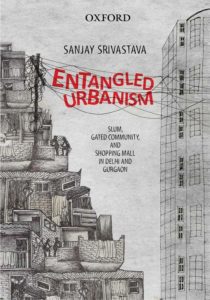Sanjay Srivastava, Professor of Sociology at the Institute of Economic Growth, Delhi, asks searching questions about how India has let its cities degenerate into chaos and highlights the surreal ways that defi ne both the dynamism and instability of its inhabitants.
 His new book Entangled Urbanism is a harsh critique of our cities and suggests ways of bringing some sanity into them. It looks at various sites in Delhi and the National Capital Region, unraveling the politics of settlement, construction, demolition, and exclusion. He covers issues like notions of citizenship, symbolic order of the nation-state; rituals of suburban life; and emergent relations between middle classes, the state, and the market, this work captures the myriad overlapping meanings of the city in all its fragments. Excerpts of his chat with ManagementNext:
His new book Entangled Urbanism is a harsh critique of our cities and suggests ways of bringing some sanity into them. It looks at various sites in Delhi and the National Capital Region, unraveling the politics of settlement, construction, demolition, and exclusion. He covers issues like notions of citizenship, symbolic order of the nation-state; rituals of suburban life; and emergent relations between middle classes, the state, and the market, this work captures the myriad overlapping meanings of the city in all its fragments. Excerpts of his chat with ManagementNext:
What is the central theme of your book?
The book explores the different ways in which seemingly separate aspects of the city are, actually, connected. Hence, for example, it seeks to foreground the fact that if one section of the urban population lives well it’s welfare might be at the cost of another section; we speak of building ‘global cities’, but what does it mean if this is sought to be achieved through removing the poor from its key parts, rather than providing them with decent housing and other resources? That is to say, if cities are to become truly inclusive, then we need to think of them as being made of interconnected spaces such that actions in one sphere have effects in another.
What are the three top trends of how urban India is evolving – good and not so good?
- Good: A growing awareness of the signifi cance of cities in national life, as opposed to an earlier overwhelming emphasis on rural India.
- Not so good: Lack of opportunities in tier 2 and 3 cities and rural areas leading to massive fl ows of poor populations to metros, without adequate provisions for their welfare.
- Not so good: lack of attention to reliable, economical and comfortable public transport leading to unsustainable levels of private car ownership and use.
The concept of gated community is creating two worlds – what impact does this have on the children living there? Increasing distance from populations that are different and decreasing empathy with the marginalized. It is leading to a sense of the city as a series of unconnected spaces.
What are your suggestions for building a more inclusive India since a large part o the population will move to urban spaces in the next decade?
- Greater availability of decent housing for economically weak populations
- Removal of stigma and police targeting of migrant populations
- Re-invigoration of regional cities
- Greater attention to the conditions of work in the urban casual sector
Anything else you’d like to add
We require an understanding of the urban condition — whether the environment, work, leisure, housing patterns or governance — that incorporate the social sciences. Cities are, in the fi rst place, social spaces and their problems cannot be solved through narrow economistic and technological thinking (with respect to the latter for example: Apps for women’s safety. Women’s safety issues are linked to how we think and this needs to be addressed; no amount of sophisticated technology can prevent rape).
 Sanjay Srivastava,
Sanjay Srivastava,
Professor of Sociology
at the Institute of
Economic Growth, Delhi





